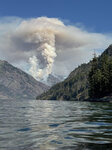

PORTLAND, Ore. — Fire Managers in the Pacific Northwest predict that many wildfires currently burning in Washington and Oregon, and potentially new ones, will persist until the region experiences significant rain or snow this fall.
Firefighters are actively battling these fires. With widespread lightning expected this month, fire managers will be adopting a strategic approach to integrate risk management, ecosystem resilience, and community involvement on long-duration fires before typical east wind events potentially arrive around the beginning of fall.
“Our planners are taking a realistic look at current wildfires, expected new fires, and the resources we have to help us safeguard human lives and property while enhancing our ability to respond to wildfires in high-risk areas,” said Jacque Buchanan, Regional Forester for the Pacific Northwest Region of the Forest Service.
Among other tactics, firefighters working long-duration wildfires will focus on identifying and preparing a network of primary and contingency containment lines to help stop fires as they approach critical areas like communities, powerlines, water supply systems, and natural and cultural resources.
“Firefighting is inherently risky. Our role as fire managers is to develop strategies that maximize success while minimizing the risk of injury or death to emergency responders,” said Kelly Kane, Acting Fire, Fuels and Aviation Director for the Pacific Northwest and Alaska Regions. “There is no structure that is worth the life of the sons, daughters, parents, siblings and friends that make up our wildland firefighting workforce.”
Long-duration fires are typical in timber-dominated forests, such as those found in Oregon and Washington, particularly along and west of the Cascades. These areas provide ample fuel that can sustain fires for extended periods and hold heat deep within the interior of a wildfire until conditions either escalate or moderate fire activity.
The steep, remote locations also make it difficult for firefighters to access wildfires on National Forest lands and present significant hazards, including rolling rocks and logs that can cause injuries. Extracting injured firefighters from these areas is also challenging and increases the risk of complications. Despite these challenges, suppression efforts to protect communities and critical areas will continue.
"Communities will likely face prolonged smoke and other impacts from these fires,” said Kane. “Large and long-duration fires vary in intensity and will continue to produce smoke as they move with wind and terrain until extinguished by significant rain or snow.”
Information on preparing for and staying safe from wildfire smoke is available at Smoke-Ready Toolbox for Wildfires | US EPA <https://www.epa.gov/air-
Comments
No comments on this item Please log in to comment by clicking here